Independence War 2: The Edge of Chaos Preview
We dive into the plot, graphics, and control of this ambitious space sim from Particle Systems.
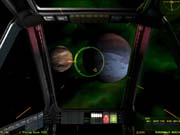
One can only imagine what the development team at Particle Systems felt when they saw the sales numbers for the original Independence War. The team worked incredibly hard to make sure the game was ready for its August 1998 release, and when it finally made it to store shelves, Independence War received widespread acclaim from gaming publications. But for some reason the mainstream gaming public just didn't latch onto the game. Some thought that the game itself was a little too complex for their tastes, while others cited the lack of a multiplayer mode to be the source of their discontent. Regardless of the reason, Independence War just didn't appeal to a wide audience, but it developed a cultlike following that undoubtedly motivated Particle Systems to go to work on a sequel. After two years of hard work and repeated attempts to figure out what could be improved and added to make the Independence War universe more appealing, Particle Systems presented us with the beta version of Independence War 2: The Edge of Chaos. Although a number of refinements still need to be made, such as cutting down on the long load times, Independence War 2 should have no problems succeeding where its predecessor failed, because it has a dynamic story, expanded gameplay, incredible visuals, and, of course, multiplayer features.
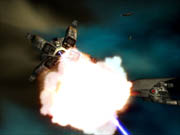
One of the most common complaints about the first Independence War is that the story is too rigid. Fortunately, Particle Systems is paying special attention to the storyline not only to make sure that it flows and keeps pace with the in-game action, but also to ensure that you connect with the game's characters. Independence War 2: Edge of Chaos starts out with a wonderfully detailed cinema, which shows Cal, the protagonist, and his father mining an enormous asteroid in two separate ships. After a few minutes, Cal's father tells his son to go home, presumably so he can finish up his work and then quickly follow him back, but you soon learn this isn't the case. After Cal leaves the asteroid, you learn that his father is involved with loan sharks, as three of their ships approach the asteroid and demand that he repay his debts. Realizing that he's in a no-win situation, Cal's father detonates his ship and takes out two of the loan sharks' ships, but the leader of the gang manages to get away. Unfortunately, Cal witnesses all of this firsthand and later decides to venture into space along with his newfound computerized companion, Clay, so he can find out more about his family's past. Unfortunately, Cal gets into trouble after a few brief missions,, and he is placed into a labor camp where he is kept for 15 years until he manages to escape - thanks to some friends he met on the "inside." From that point on, whatever Cal decides to do in space or whatever course of action he takes is entirely up to you, but don't be surprised if you find yourself uncovering an enormous government conspiracy.
Second Star To The Right
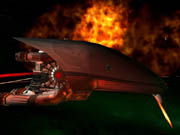
In Independence War 2: The Edge of Chaos, there are a number of elements at work that give you the feeling of complete control over the game: Depending on which missions you decide to undertake or avoid, you determine how the story progresses. For example, you can make Cal and his coworkers become interstellar pirates, much like Cal's relatives, by accepting missions where you intercept convoys or merchant ships and seize their cargo. It is also possible to become a mercenary of sorts, as other missions require you to engage in combat against an enemy that you may hardly be familiar with. Obviously, logical story progression can be difficult to keep track of if you're constantly interacting in side missions that have very little relevance to the main plot. To remedy this problem, Particle Systems sets a variable level of importance on some of the missions - some missions are of great importance and require your immediate attention while others are less important and can be dealt with at your leisure. If you decide not to undertake an important mission or if you don't complete it within a reasonable amount of time, your decision will more than likely affect how the plot unfolds.
To help complement the feeling of freedom in Independence War 2: The Edge of Chaos, Particle Systems has developed an excellent navigation system that lets you cruise to just about any area of the surrounding galaxy within a short period of time. In addition to the traditional use of waypoints, which can be found in just about any other space simulation, Independence War 2 uses jump accelerators - devices that enable your ship to travel great distances in a short of amount of time. The only catch is that you cannot simply activate the jump accelerator at any time, especially around space stations; instead, you have to travel to a safe jump-accelerator area, plot your course, and then take off. Collisions with planets, space stations, or other large objects are not a problem, because your ship automatically avoids all of those obstacles. However, your ship is still susceptible to attacks from other ships during a jump-accelerator run, so it's wise to keep an eye on the radar just to make sure that there aren't any enemy craft in the immediate area. Of course, you can also avoid using jump accelerators altogether and travel to different points on the map under your ship's top speed; however, not only does it take a ridiculous amount of time to reach your destination using this method (Particle Systems said it would in fact take months to reach some areas under normal conditions), but you also take a higher risk in getting ambushed by enemy craft.
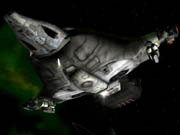
Getting around the galaxy isn't difficult at all. The autopilot, which can be found by pressing a few buttons inside the pilot HUD menu, displays all types of information about your ship and does most of the work in bringing you to a desired destination. Moreover, you have access to an enormous star map, with major locations clearly pointed out by an icon. When you want to travel to an area, all you have to do is enter the star map, select a destination, and you can sit back and let the autopilot do its job. The navigation system is a clear example of Particle Systems' dedication to making Independence War 2 accessible to everyone.
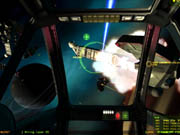
Piloting in Space 101
While navigating to new stations, planets, or asteroids in Independence War 2 is a relatively easy task, manually piloting your ship is not quite as simple, especially in your first few test runs of Cal's new spacecraft. In addition to adding entirely new features to the Independence War universe, Particle Systems is refining preexisting features, like the physics engine. The result is an incredibly realistic space-flight simulation, where your ship can quickly go into an uncontrollable spin if you don't monitor the amount of pressure you're applying to the control stick. During your first few flights, you can expect that type of situation to occur quite a bit, but after you begin to learn how the ship reacts to different amounts of pressure, you should have no trouble flying in a straight line. For those looking for an added challenge, it's actually possible to turn off the built-in flight-assist mode, which prevents you from losing complete control of your craft. If you do turn off the assists, you not only have to worry about your ship spinning on its axis, but now you also have to worry about the ship's momentum carrying it into a nearby obstacle. Either way, it's still fairly difficult to become a solid pilot right away, but by using the training area right outside the hidden base formerly inhabited by Cal's grandmother, you can learn the basics of ship control in a safer environment.
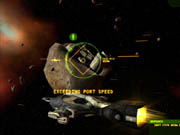
Learning how to control Cal's first ship is important because later on in the game you're going to have to adjust your piloting skills after you begin attaching different types of craft to Cal's craft - otherwise known as the command section. One of the more intriguing aspects of Independence War 2's gameplay is that you can essentially customize your ship depending on the type of mission you want to embark on and what you have in your inventory. To get any attachments for your ship, you actually have to capture them - presumably during one of Cal's many pirate raids on merchant ships and convoys. Once you have secured added hardware, you have the option of adding it to your ship when you're in the space-station screen. However, keep in mind that adding more guns or new parts to your ship can have a dramatic effect on the ship's performance, which can then impact the quality of your piloting skills. Eventually, the types of ships you command continue to grow until you get to the point where you can actually attach two miniships, piloted by Cal's friend from the prison, to the hull. At any point during the game, you can detach the two miniships and give them an order from the standard list of attack, attack the target, or protect and defend. This feature adds a nice strategical element to Independence War 2 - one that will no doubt play a major role within the multiplayer modes.
Final Thoughts
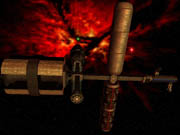
Space simulators have always set high standards when it comes to visual quality. Previous games have used a lot of special effects that weren't especially common in games of other genres - Independence War 2: The Edge of Chaos is no different. The amount of detail on each ship is staggering. When you switch to the third-person-perspective camera to get a better look at Cal's ship, you can really appreciate the effort put forth by the developers behind the game. Each panel of the ship is clearly visible as are slight variations in color and quality, due to parts of the ship being rusty or dirty. Also in the third-person-camera mode, you can get a good look at the fully polygonal cockpit complete with a small character model of Cal. There are also an insane number of light sources at work in Independence War 2. Individual lights on the ship, located on the wings and at the rear of the craft, light up individual sections, and the cockpit itself is bathed in the red glow of the two interior lights. Moreover, the light sources in the background, such as stars and nebulae, have a profound impact on the colored lighting and the way the shadows are cast on the ship. Even smaller details, such as the star field, seem to come alive with a subtle blurring effect each time your ship moves in any direction.
Although there isn't going to be a persistent online universe, multiplayer mode still plays an important role in Independence War 2. There are standard deathmatch modes, where several ships can do battle, as well as a capture-the-pod mode, which is just a slight twist on the capture-the-flag mode that you find in first-person shooters. In addition, Particle Systems' dynamic scripting tool, named POG, lets you create your own content for both the single- and multiplayer modes, so Independence War 2 should have no problem being accepted by the vast user-modification audience.
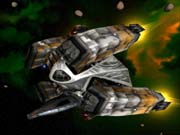
Independence War is a great game, but because of the overly complicated gameplay and lack of a multiplayer mode, the game failed to make an impression on the general gaming audience. Instead of simply releasing the same game with minor modifications, Particle Systems took the feedback from players and went into the planning stages of Independence War 2 with a good idea of what needed to be changed, what could be refined, and what needed to be added. After two years, Independence War 2 is nearly finished, and from what we have seen of the early beta build, it's clear that Particle Systems is on track to making Independence War 2 appealing to a more general audience.
Got a news tip or want to contact us directly? Email news@gamespot.com
Join the conversation